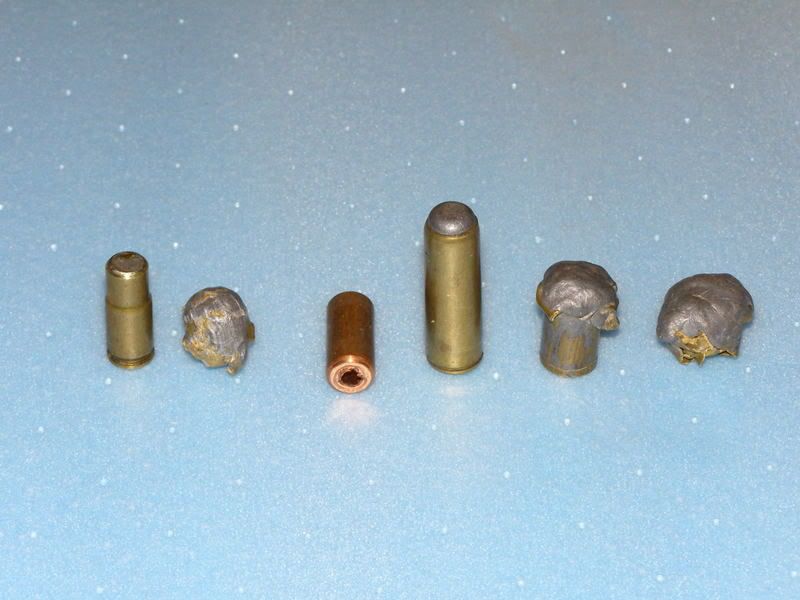| DarylS |
| (.700 member) |
| 02/07/13 12:52 AM |

|
|
|
With a nominal .460" head, the .405 case is indeed close to the .30/40 Krag's .457". The .303 Brit. also has a .457" head diameter, which is why .303 brass works so well for .457" bullet jackets.
The 3 on the right are from .303 cases.
2nd form the right has a WW alloy core and made 14 1/2" into a -40C Green Railway tie smashing 2, 3" glass hard knots on it's way. The right hand bullet, with a pure lead core, made only 12" into the same fir tie, yet smashed 1 of the 3" diameter knots. Both bullets had an almost 1/2" diameter wad of wood fiber would up in a spiral mass in front of them, which was being pushed forward by the bullets as they penetrated increasing increasing the woud channel's diameter as they pushed into the material. It was amazing - tough stuff - Douglas Fir! When straighted out, those small ropes of wound up wood fibers extended right back, almost to the surface of the tie where the bullets struck.
.303's have more uses than one realizes. both cores were sort of bonded as well. I roughed the interiors with 0 steel wool, then cleaned them and wiped the interiors of the cases with solder flux on a cotton cue tip, before pouring their cores. A sizer die was used to turn the noses into the bullet's end, slightly as you can see in the picture.
The pure lead ones would make interesting hog bullets.
The bullet on the left is made from a .30 Luger case, I think. The next one in, expanded, was a 200gr. .30 M1 Carbine case'd bullet, shot from my .358 Norma Mag at something like 3,000fps into frozen Aspen log. It made almost 2' of penetration, splitting the small 8" log into 2 pieces. I think they'd make good hog bullets too.
.223 brass, discarded all over the range here, make decent .375's. No body seems to load this stuff, any more.
The copper tube is .375OD. The dull pipe cutter I used to cut it off, leaves a lot of flashing, which helps seal the base. A .375" base pour mould (I've used Lyman) is bored to the crimp groove to take this piece of .375 tubing. Melt the lead, heat the mould, drop in a 'brass' jacket, pour the bullet. Then drop from the mould, an X weight .375 jacketed bullet with whatever core alloy you want. I've only shot these to 2,500fps, but they worked perfectly. If using WW alloy, you can turn these almost into FMJ type FN bullets by heat treating the cores after casting. heat them to about 475F (10F under 'slump' temp) then quench. 12 hours later, they'll run 30 brinel or more.
We've just discovered that .40 S&W ctg. brass are about .4295", perfect for .44 mags and .444 Marlin bullets.
